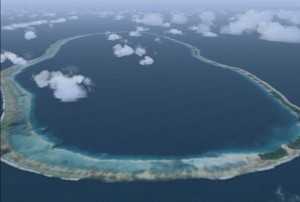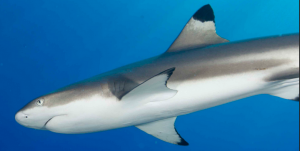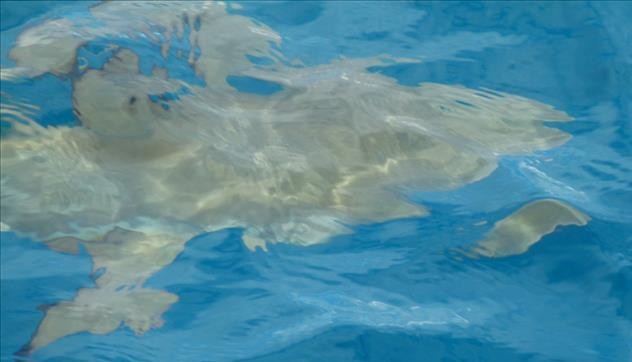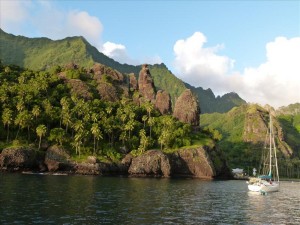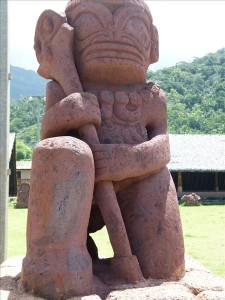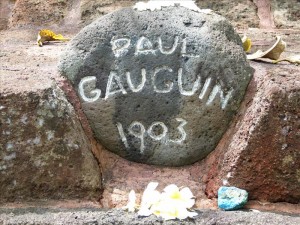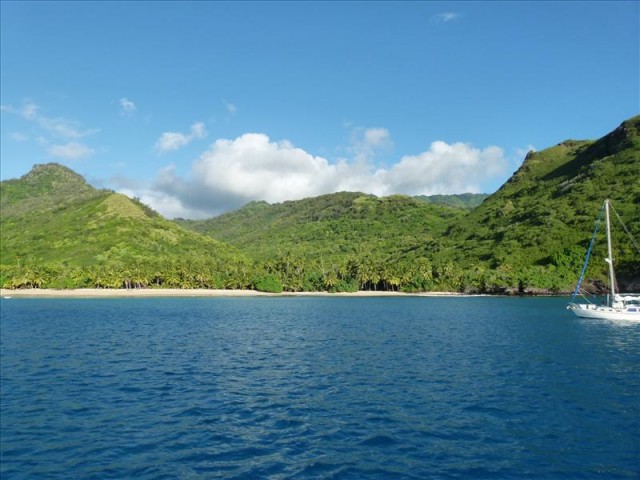
Tahitian black pearls, showing several variations. Photo courtesy of http://www.antique-jewelry-investor.com/Tahitian-Black-Pearls.html.
Manu, the young man running the pearl farm just north of town, showed a small group of cruisers around one afternoon. When we visited, the farm was grafting, meaning that the workers were introducing a foreign object into each oyster as the nucleus of a new pearl. The creature would then over time coat the nucleus with whatever it is that makes the nacreous coating. Voilà, pearls.
As you might imagine, pearl farming is very labor intensive, lots of manual piece work: first, workers in boats and in the water retrieve many dozens of strings of oysters from the lagoon, where they hang from floats in 5 or 10 meters of water. Then, other groups of workers have to get each oyster off the string from which it hangs, clean it up a bit, wedge it open, stick an implant into it, rewire it onto the string, and replace the string in the farm.
The oysters dangle ten or twenty to a length of rope that hangs vertically with a few others inside a plastic mesh cage, which in turn hangs from a float. Each oyster is attached to the rope with a slender wire, which passes through a man-made hole drilled in the shell.
Not every oyster pulled from the water gets an implant. Some, after having the worst of the ocean crud chipped off their outer shells and undergoing a quick inspection, are deemed unready for an implant and are immediately rehung on a rope and replaced in the water. I couldn’t tell what qualifies an oyster as ready. This was just the first illustration of how low the pearl yield is compared to the number of oysters in the farm.
If an oyster is ready, a worker taps a small plastic wedge between the halves of the shell to crack it open. Then a skilled operator opens the oyster up a bit further, cleans out some goop from one particular area of the interior, deftly manipulates the creature inside and implants a spherical shell about 5 mm in diameter with a specialized instrument about the size and shape of a dental tool, adds a tiny dab of red goo, and closes the oyster up. With the grafting complete, another worker again wires the oyster onto a rope that will again be suspended with a few others inside a cluster that in turn gets heaved onto a panga so still other workers can take it out to the farm and reattach it to a float.
Miscellaneous bits:
- It takes 9-14 months for an oyster to generate a pearl.
- It’s very labor intensive to culture pearls, and the success rate is low. Roughly two-thirds of the oysters that come out of the water receive implants. About 50% of the oysters that receive implants generate pearls. Of those, about 25% generate marketable pearls. Thus, if a farm has, say, one million oysters, it can expect to harvest roughly 80,000-85,000 marketable pearls, a success rate of well under 10%. And of those pearls, only a fraction will fetch top prices.
- The red goo the grafter inserts somehow affects (along with characteristics of the local sea water) the final color of the pearl.
- Chinese workers do the grafting – apparently they are more dextrous, or something, and the local guys do the grunt work, the heavy lifting. All the work is manual and extremely repetitive and tedious.
- Different atolls and islands produce pearls of different colors; pearl farmers add goo of different colors, whatever works best in each farm’s location.
- The object stuck inside the oyster to stimulate development of the pearl is itself a shell, almost perfectly spherical; the shells come from the Mississippi River.
- Factors affecting the price of the pearl include size, surface quality, shape, iridescence, and color. The larger, smoother, more perfectly spherical, and “deeper” (more translucent or lustrous) the finish, the better. White is the least valued color; true black is the rarest and most precious. The harvested pearls get evaluated one by one and color alone doesn’t dictate a price level.
- So-called “black” pearls, for which the Tuamotus and especially the Gambiers are famous, aren’t necessarily black — they can be gray/silvery or have hues of green, pink, yellow, or blue. They all come from the black-lipped oyster.
- In 2008, cultured pearls constituted about 55% of French Polynesia’s exports. The pearl industry has fallen on hard times since then, because of the worldwide recession.
Manu of course had pearls for sale, sorted into several small containers according to quality. His most expensive pearl, probably 10 mm in diameter, perfectly shaped and with a lustrous finish you could virtually see into, cost CFP 28,000 (about US $280). His least expensive, apart from the tiny little seed he gave to one of the kids in our group, was CFP 1,000 (about US $10).
If it is not illegal to buy directly from pearl farmers the practice is at least strongly discouraged (according to some mainstream travel book or other) because pearls are supposed to be officially assayed or tested for quality before going on the market, ostensibly to protect consumers from being cheated by the farmers. Not to be overly cynical, but I suspect it’s also because the government wants to impose some sort of tax.
I think it is also illegal to take pearls out of the country that are not mounted in some sort of jewelry – necklace, ring, bracelet, or whatever. Stories abound of individuals cannily buying choice pearls and having them inexpensively strung, then taking them to Paris and reselling them for vast profits. Maybe. Certainly the items for sale in Tahiti will be very expensive, at least twice the price that someone like Manu would charge – but those will be the choice pearls, all fluffed and buffed and mounted in some sort of jewelry and ready for the unknowing tourists. In any case and regardless of location, caveat emptor.
[Later: I happened to walk past Tahiti Pearl Market, one of the top-rated and most reputable pearl jewelers in Papeete, and ended up in a conversation with one of the representatives. I asked about a few necklaces in the store window. The most modest, consisting of 37 pearls all 11 mm in diameter, looking uniformly spherical and perfect to the untrained eye, in subtle hues of blue, yellow, silver, and pink, sported a CFP 2.2 million price tag. That’s not quite US $21,000, or about $567 per pearl. Another necklace ran CFP 3 million (a touch more than US $28,500), and the largest and most elaborate necklace, a thick braid of three strands of pearls, could be yours for a mere CFP 3.5 million (about US $33,335). Tahiti Pearl Market gets its pearls from its own farms, one in Fakarava and the other in <didn’t catch the name>.]
One of our crew bought $500 worth of pearls from Manu, of different shapes and at various quality levels, which she will make into jewelry when back in the States. Another cruiser opined quietly on the side that Manu’s prices seemed quite high compared to prices in the Marquesas. I don’t see how making that comparison is possible without having experts from the different places evaluate exactly the same pearls, as they vary so much in so many different ways.

Still more black pearls, variations and irregularities even more evident. Photo courtesy of http://www.sea.edu/spice_atlas/rangiroa_atlas/polynesian_black_pearl_industry.

